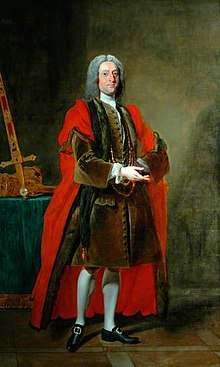Sir John Lister Kaye, 1st Baronet

Sir John Lister-Kaye, 1st Baronet (1772 – 28 February 1827) was a noted English amateur cricketer in the late 18th century. His career spanned the 1787 to 1798 seasons and he played mainly for Marylebone Cricket Club and Surrey. He made 12 known appearances in first-class cricket matches.
An illegitimate son of a baronet, he was created a baronet in his own right in December 1812 when he inherited the Lister estates by will.[1] He lived at Denby Grange near Wakefield, Yorkshire. One of his sons, George Lister-Kaye (1803–1871), made a single first-class cricket appearance for Sussex in 1828.
Yorkshire gentry
John Lister-Kaye was born at Denby Grange between Wakefield and Huddersfield in the West Riding of Yorkshire. The illegitimate son of Sir John Lister-Kay, 5th Baronet of Denby Grange, he was the sole heir to both the Lister and Kaye families, ancient Yorkshire pedigrees stretching back to the middle ages. According to tradition, the family was descended from one of King Arthur's Knights of the Round Table. The original feudal lord was Sir John Kaye, a knight who came over with William the Conqueror and married the daughter of Sir John of Woodsham. His grandson married the heiress of Crompton, Lancashire, establishing the two main branches of Kaye in the northern Palatinates. One son of Kaye married into the Tory Squires family, Danby knights of Masham. On 4 February 1641 Sir John of Woodsome rode out in support of King Charles I and was created a baronet for his services to the Royalist army. He died unmarried in 1789, leaving his estates to his natural son, while the title devolved to his younger half-brother, Sir Richard Kaye, 6th Baronet who was Dean of Lincoln Cathedral. Having no legitimate children, the baronetcy expired on the sixth baronet's death on Christmas Day 1809.[1]
Sir John's acquisition of the landed estates devised on him was the cause for entitlement for a baronetcy, when George III created a new title by patent on 28 December 1812. His land included the Manors of Burton (or Kirkburton), Woodsham, Shelley and other lands in Yorkshire. The country was at war with France and under very serious threat of invasion. The Yorkshire squirearchy was designated responsibility for being officers of the local militia mobilised to keep law and order and police the coasts of England, as nightwatchmen. Their powers had been created by parliament in the Militia Act 1757, which remained in force for a century.
Sir John married Lady Amelia Grey, sixth daughter of George Grey, Earl of Stamford and Warrington on 18 October 1800 at Bowden Church in Cheshire. The society marriage strengthened his entitlement. The couple had four sons and six daughters:[2]
- Sir John Lister-Kaye, 2nd baronet (18 August 1801 – 13 April 1871), married 21 October 1824 Matilda Arbuthnot, sole heiress of George Arbuthnot (1764–1805)
- Capt. George Lister-Kaye (14 November 1803 – 18 September 1871) 10th Dragoons
- Amelia Mary Lister Kaye (14 November 1803 – 20 February 1826), married Falkiner Caleb Arthur Chute Sandes
- Arthur Lister Kaye (14 January 1805 – buried 25 February 1834) rector of Thornton, Yorkshire
- Sophia Lister Kaye (23 September - 19 December 1807)
- Sophia Charlotte Lister Kaye (31 March 1809 – 17 February 1877) married Rev. Henry Spencer Markham of Clifton Rectory, Notts.
- Louisa Lister Kaye (28 September 1810 – )
- Henrietta Emilia Lister Kaye (28 December 1811 – 15 October 1878)
- Maria Lister Kaye (17 March 1813 – )
- Henry Lister Lister-Kaye (14 June 1814 – )
- Georgiana Lister Kaye (11 September 1815 – 29 July 1877), married William Ford Hulton of Hulton Park
When Sir John sold a portion of the Burton inheritance in 1827, it devolved on the Sykes family of Sledmere. Sir John died on 28 February 1827.
Arms: Quarterly, 1st & 4th: argent, two bendlets, sable (Kaye); 2nd & 3rd: Ermine on a fess sable three mullets or (Lister); the whole within a bordure wavy azure.
Crests: 1 Agoldfinch proper, proper charged on the breast with a rose gules. 2 LISTER on a wreath of the colours a buck's head proper, erased wavy or attired sable, in the mouth a bird bolt bendways of the third, flighted argent (for LISTER).
Motto: Kynd kynn knowne kepe
References
- 1 2 Mosley, Charles, ed. (2003). Burke's Peerage, Baronetage & Knighthood (107 ed.). Burke's Peerage & Gentry. pp. 2363-. ISBN 0-9711966-2-1.
- ↑ The Baronetage of England. Volume 24 Publisher F.C. and J. Rivington, 1819 Original from National Library of the Netherlands 639 pages, pp.1213–1218
Further reading
- Arthur Haygarth, Scores & Biographies, Volume 1 (1744–1826), Lillywhite, 1862
- Edward Cave, The Gentleman's Magazine, vol.97, part 1, reprinted by Princeton University, 2009
- Burkes' Peerage and Gentry, Cassells, 2003 in 2 vols.